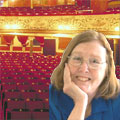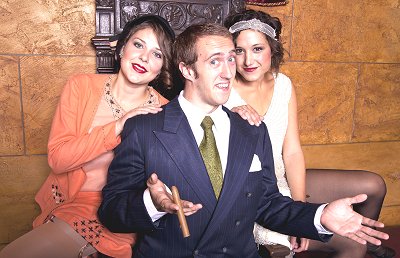- By Judith Pratt
- Entertainment
 Print
Print  The Story
The StoryChicago first appeared on Broadway in 1975, with Gwen Verdon as Roxy and Bob Fosse directing. You may have seen the 1996 revival, or the 2002 movie. With its many great female roles, it’s perfect for a college musical theatre production—as long as the students can sing, dance, and act. They can.
The Production
You’ve got Megan Watt as cutely tough Roxy, and Rebecca Futterman as her long cold rival, both able to belt out a song and croon a ballad. You’ve got Jessica Bennett as Mama Morton, tough and tender matron of the cellblock that holds Roxy, Velma, and a half-dozen brilliant babes. And you’ve got D. Resto as reporter Mary Sunshine, using a glass-breaking soprano to parody vaudevillians like the Cherry Sisters.
 Megan Watt as Roxy Hart, Daniel Lindgren as Billy Flynn, and Rebecca Futterman as Velma Kelly. Photo by Samite
Megan Watt as Roxy Hart, Daniel Lindgren as Billy Flynn, and Rebecca Futterman as Velma Kelly. Photo by SamiteSubtitled “A Vaudeville,” Chicago pays homage to each kind of act, giving every cast member a chance to shine. Like Danny Lindgren, as the fancy lawyer Billy Flynn, who “Razzle Dazzles” us, or Tim Quartier, as Roxy’s long-suffering husband Amos, breaking our hearts with “Cellophane.”
Greg Bostwick, as director, and Mary Corsaro, as choreographer, put it all together. Corsaro knows how to meld historic dance styles with today’s energies—and those kids can dance! Bostwick not only kept the pace from being too frantic, he also got strong acting performances out of everyone in the cast.
The Theme
At the beginning, the show seems to be all for fun, presenting the glorious foolishness of jazz age Chicago. By the end, with Roxy and Velma frantically dancing on an empty stage, we realize that this musical has something to say. That it’s all about the latest public scandal, driven by media attention, for a world with the attention span of a gnat. That everyone is out for herself. That them that has, gets.
As my date said, the more things change, the more they stay the same.
Professional Designers
Not until after the show, when I read the program, did I realize that the entire design team was made up of Ithaca College Theatre Department alumni who have been working in the profession. Prime among them is Paul Gallo, a well-known lighting designer, who created an astonishing spectacle of lights. Kara Harmon’s glitzy costumes shone. Daniel Meeker’s scenic design included an old-fashioned vaudeville curtain and a bunch of sliding platforms that kept things moving. These pros donated their time, and each had a student assistant. What a great experience
----
v6i42



